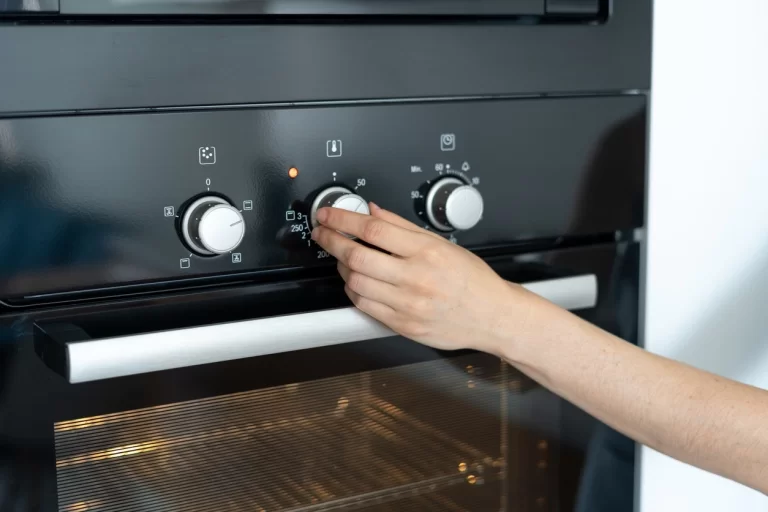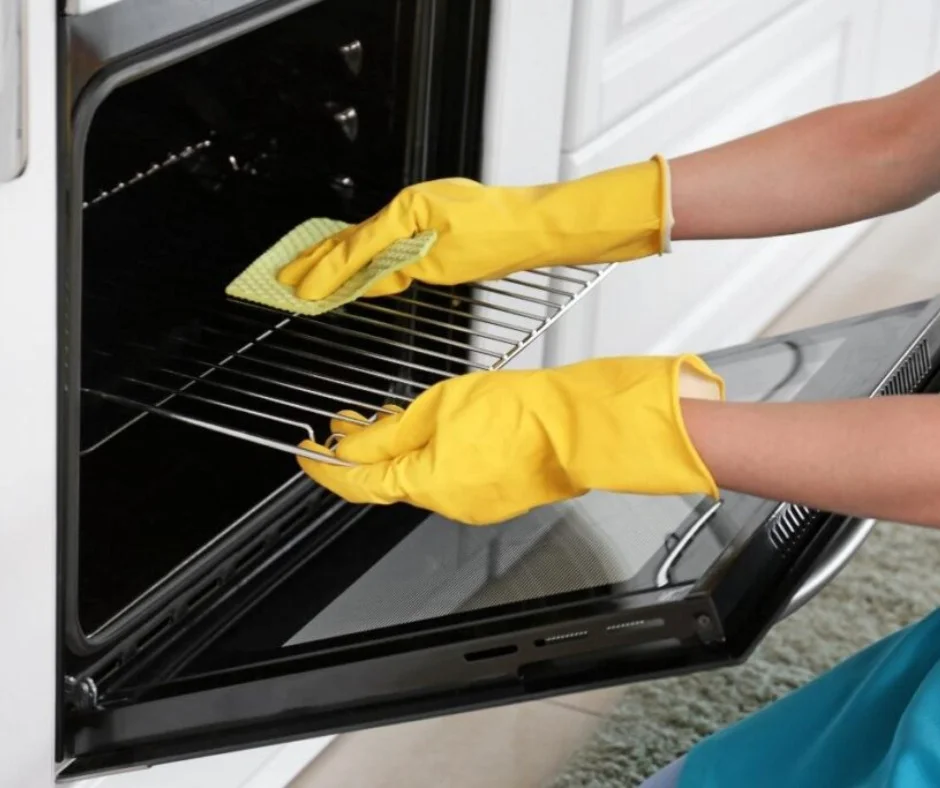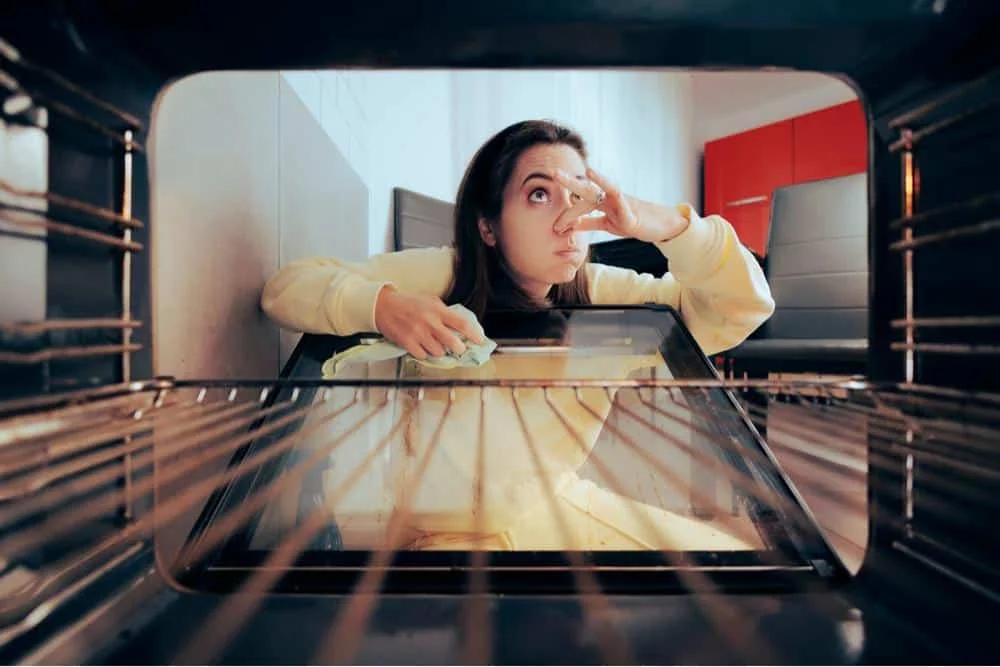A self-cleaning oven can be an efficient solution to remove oven spills and baked-on oil. Despite the convenience, there are questions regarding the safety of these seemingly miraculous equipment. Can self-cleaning ovens endanger your health and safety? Let’s get into the details and discover the truth behind the rumors.

How Do Self-Cleaning Ovens Work?
Self-cleaning ovens use high temperatures (up to 900°F) to burn off food residue and grease, leaving a pile of ash that may be easily wiped away after the cleaning cycle is finished. During this cycle, any food scraps or grease are burned and reduced to ash, which can then be readily removed with a moist cloth once the oven has cooled. The high heat helps clean areas that are difficult to reach by hand.
Most models offer a self-cleaning cycle that shuts the oven door for safety while it works, which can take 2-4 hours.
Why People Use the Self-Cleaning Oven Feature?
Self-cleaning ovens are appealing because they ease kitchen maintenance. The high heat can clean hard-to-reach locations such as the back oven wall and the bottom heating element. Food odors and oven dirt are burnt away during the self-clean cycle. Users can start the cleaning cycle and walk away, leaving the oven to perform the dirty work. This function is particularly popular with busy individuals and families that value convenience and time-saving solutions in their daily lives.

Is It Safe to Use a Self-Cleaning Oven?
For most people utilizing conventional safety procedures, yes, when properly operated and totally shut during the cleaning cycle. Here are some tips for safe operations:
- Ventilate your kitchen: Before self-cleaning, open the windows and put on the kitchen and bathroom fans. The oven will emit strong scents and smoke during the cycle. Proper ventilation is essential.
- Remove oven racks – When exposed to high temperatures, oven racks may discolor or deform. Remove them before beginning the self-cleaning cycle.
- Wipe out oven grease – Use a towel to remove any significant grease deposits before self-cleaning. This will help prevent smoking and flare ups.
- Clean the door gasket Pay great care to cleaning the door gasket before and after usage. This ensures a good seal during cleaning.
- Do not leave your home – Do not leave dogs or young children alone in the house during the cleaning cycle, since there is a risk of burns or smoke inhalation.
Additionally, users should avoid touching the oven during the cleaning process and refrain from placing any flammable objects nearby.
Why Are Self-Cleaning Ovens So Dangerous To Use?
Despite their convenience, self-cleaning ovens might pose a risk if not used properly. One of the primary concerns is the possibility of carbon monoxide poisoning, especially in older models with inadequate ventilation systems. The extremely high temperatures of self-cleaning ovens pose risks:
- Fire hazard – Grease or food residue burns can ignite at high heat. Flare ups are possible.
- Dangerous fumes – During the cleaning cycle, organic matter inside the oven is burnt, emitting carbon monoxide gas as a result. Without adequate ventilation, this odorless and colorless gas can accumulate in the kitchen, posing a major health risk to the occupants.
- Heat damage – Plastics left in the oven may melt. Door gaskets might be damaged.
- Burn hazard – The hot oven surfaces might result in severe contact burns. The outside of the oven can reach dangerously high temperatures.
- Pet/child danger – During self-cleaning, fumes or contact burns pose a risk to pets and unattended children.
While convenient, the self-cleaning procedure essentially starts a enclosed grease fire within your oven at around 1000°F. Taking the necessary precautions is vital.
Can Self-Cleaning Oven Kill You?
While the prospect of a self-cleaning oven causing injury may sound frightening, the chances of it really becoming lethal are slim. However, some variables, such as insufficient ventilation or pre-existing respiratory disorders, can heighten the likelihood of negative health consequences. In extreme situations, persistent exposure to high levels of carbon monoxide can lead to death. As a result, when using a self-cleaning oven, exercise extreme caution and adhere to all safety requirements. Every year, millions of households utilize a self-clean cycle safely, taking the necessary safeguards. The benefits nearly always outweigh the small risks.
Alternatives to Self Cleaning Mode
If you’re not comfortable using the oven’s self-clean feature, you can still effectively clean it with a little more human effort:
- Do a steam clean Place a shallow pan of water in an oven preheated to 350°F. After 20-30 minutes, the steam will assist release any baked-on spills. Scrub using oven cleaning and scouring pads.
- Baking soda scrub: Make a paste using baking soda and water. Apply to oven surfaces and allow to sit before carefully cleaning and washing them. The grit helps to eliminate dirt.
- Vinegar Rinse: Wipe off cooled oven surfaces with undiluted white vinegar. It cuts through grease and removes odors naturally.
With a little extra effort and elbow grease, you may completely bypass the self-clean cycle and safely remove stubborn oven soil.

Conclusion
While self-cleaning ovens are a simple, hands-off way to remove baked-on fat and food residue, they also represent some safety risks owing to intense heat, which all users should be aware of. Users can enjoy the benefits of a self-cleaning oven without jeopardizing their health or safety if they recognize the potential hazards and take suitable safety measures. So, can self-cleaning ovens kill you? While it is improbable, their usage should be approached with caution and mindfulness.
FAQs
Fortunately, those fumes are not harmful to breathe in, but they are very unpleasant to smell. A self cleaning oven will stink up your house easily if you don’t properly ventilate the space. Opening windows and doors can help clear out the fumes sooner than later.
It has been revealed that the self cleaning feature on ovens can cause a build-up of Carbon Monoxide gas. It is hard to detect Carbon Monoxide, which is why it is even more dangerous because the gas might be being released in the air without you knowing, and it can cause poisoning if not detected.
How Long Does a Self-Cleaning Oven Take? Most ovens will let you select how long to run the cycle, usually anywhere from two to six hours. Select more or less time depending on how dirty the oven is. Hand-cleaning the oven as spills happen will make cleaning up after a self-clean cycle easier.
When exposed to 600 degrees Fahrenheit (or higher) during the oven cleaning, the off-gassing is very toxic to humans, especially babies, young children, and pregnant women. The fumes can also cause flu-like symptoms, such as sweating and coughing, and trigger asthma.
Sources:
- Is it Dangerous to Use Your Oven’s Self Clean Feature?
- Here’s Why You Shouldn’t Use Your Oven’s Self-Cleaning Function
- Why You should NOT use Self-Cleaning Oven Feature
- 5 Dangers of Self-Cleaning Ovens
- Is It Safe to Run Your Oven’s Self-Clean Cycle?
- Can A Self-Cleaning Oven Kill You?
- Safety and Chemistry of the Self-Cleaning Oven
- What are the Dangers of a Self-Cleaning Oven?
- Is It Safe to Use a Self-Cleaning Oven?
- Why a self cleaning oven is dangerous
- Yes, there are safety concerns with using the self-cleaning feature on an oven
- How to Use the Self-Cleaning Mode on Your Oven
- 3 Potential Dangers of the Self-Cleaning Oven Cycle
- Experts Warn Against Using the Self-Cleaning Feature on Your Oven—Here’s Why
- What You Need to Know Before Starting Your Oven’s Self-Cleaning Cycle
- Self Cleaning Ovens: Risks & Rewards
- What Happens If You Turn Off Self-cleaning Oven Early?
- Why You should Never Run A Self Clean Oven Cycle & A Safer Alternative